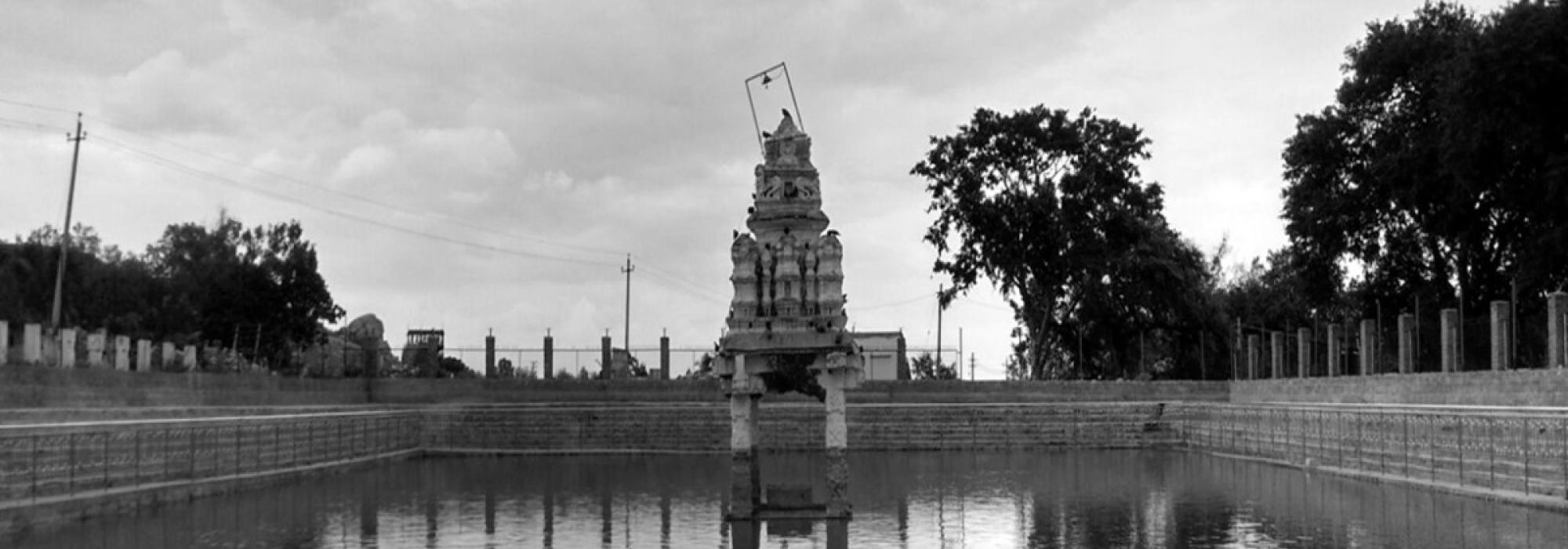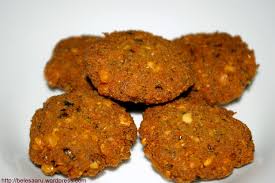Sri Chandrashekhara Sastri belonged to the Hulusukamme (or Ulucukamme) Brahmana subsect hailing from Srinivasapura. He arrived in Mulabagal as the Headmaster of the Anglo Vernacular School. He earned the respect of all people owing to his character, scholarship, and work ethic. His elder brother Sri Nanjunda Sastri was a renowned Vedic Guru; his younger brother, Sri Subbasastri made a name for himself as the schoolmaster in a place named Yerukaluve. The chief characteristic features in the personality of Sri Chandrashekhara Sastri were: (1) his radiant face (2) his bronzy voice (3) his prowess in delivering discourses (4) his short temper. He always carried a wooden ruler in his hand. Any student who committed a mistake would suffer a blow on his knuckles. At times, he would also pinch the student’s jaw. There was no paucity of lexicon when he began raining abuses, a majority of them in Telugu. Some stock abuses included, “Verri Vedhava” (Mad Villain), “Yedichi Mukham Kadigikonnattu” (You look like you’ve washed your face with tears), and so on. He would supply sarcastic nicknames to students (One of this is “Kurraya,” mentioned in an earlier essay). He anointed this poor writer with the moniker of “Madanakumara.” Another student was named “Kandanagadu.” Because he was short-tempered, we were scared of him. Because he also had a great sense of humour, we admired him. And because he had an innate reverence for knowledge, we respected him. Students hailing from various Varnas attended his classes. Apart from Brahmanas, there were Komatis [typically, people belonging to the merchant and shopkeeping class], Ganigas [oil producers], Agasas [washermen], Sunnakallu [limestone makers], and Banajigas [traders]. Sri Sastri’s fury and mirth was impartially distributed among all students.
Kavya Lessons
Sri Chandrashekhara Sastri’s lessons were harvests of charming and lighthearted literature. Even while explaining a relatively simple lyric like “Gajavadana heramba,” he would make us narrate the etymology of each word-form, word order and meaning, intent, splitting of compound words, gender, number, and case. Although students were scared of receiving blows when they made mistakes in this process of learning, they would forget every fear thanks to the sheer joy they experienced from Sri Sastri’s exposition of poetry. He had a truly splendid voice, a magnificent style of diction. Be it Kannada poetry or Sanskrit verse, the emotion embedded in it would directly touch the listener’s mind by the sheer force of his diction. If one needs to savour the beauty of the rendition of alphabets and words, one must serve at the feet of people who narrate poetry like Sri Chandrashekhara Sastri.
Vedic Chanting
It was a pure treat to relish the majesty of Sri Chandrashekhara Sastri’s prowess in Vedic chanting on occasions like the Upakarma (Thread Ceremony) and other Vedic rituals. He would assist Sri Venkatarama Bhatta on such occasions. He was much younger to Sri Venkatarama Bhatta. They had mutual admiration in matters of having an abiding reverence for knowledge and in following traditions. In case of rituals like Homams and Havanams, Sri Venkatarama Bhatta would place Sri Chandrashekhara Sastri in the seat[i] of the Brahma. Both of them would chant mantras together. In the Kartika month, Sri Chandrashekhara Sastri would unfailingly arrive at the Someshwara Temple for the Deeparadhana[ii]. He would serve the Someshwara Deity by chanting a selection from the Veda or a Kavya as part of the Mantrapushpa[iii] offering. Brahmatmanvadasrujata…was his favourite Mantra. He would ecstatically recite the yesha mrigAnkOpi…from the Champu Ramayana [authored by Bhojaraja]. At mealtime, folks gathered there would be more interested in Sri Chandrashekhara Sastri’s poetry recitation than food. Although Sri Sastri had mastered several Ragas, he showed special inclination towards Kedaragowla. The moment he took up a verse and began to sing it in this dignified Raga, the entire assembly would lapse into stillness akin to an exquisite sculpture. That was the beauty of his voice and his command over the emotion of the Raga. On occasion, I was performing the Sandhyavandanam. This had to be followed by the Agnikaryam. Sri Chandrashekhara Sastri arrived at that exact time. When he saw me performing the Sandhyavandanam, he came over and sat nearby. My thread ceremony had been performed just a few days ago. His intent was to observe the manner in which I chanted Mantras. As I chanted the Sankalpa Mantra for my Agnikaryam, I said—Sri Parameshwara prItyartham….asmAkam. Immediately, Sri Chandrashekhara Sastri said in Telugu: “Oho! Have you already acquired a family?” Everyone at home burst out laughing. Eventually, this became a standing joke in town. Sri Sastri spread this incident even at school.
Cooking Prowess
Sri Chandrashekhara Sastri was a fine gastronomic connoisseur. He excelled at preparing a vast array of broths and curries. On the day of the Shasti (Sixth Day of the Fortnight), he would invite me to his home for meals, wash my feet[iv] and offer me a Dhoti. Lunch would then follow. A feast involving Ambode (a kind of Vada), Payasam and other delicacies. But what I found the most delightful was his Rasam. He would add a dash of coconut water and grated copra. When I asked him why he offered me Dhoti, he would say, “You’re a Brahmana. You need to take it. And you also need to accept the Dakshina.” Everybody would laugh at this. When he saw my grandmother, he’d say, “Mother, it’s been so long since I ate that curry powder you prepared!” It’s not an exaggeration to say that I have been greatly influenced by Sri Chandrashekhara Sastri. He had known hardship in life. He had seen suffering in his family life. He had undergone poverty. He stood rock-like in the midst of immense calamity and poverty without losing heart. One of his favourite works was Shivaparadha Kshamapana Stotram (composed by Adi Shakara). Those who heard him recite this in the Someshwara Temple invariably experienced a deep stirring within their own lives: KshantavyO mEparAdhah shiva shiva shiva bhO sri Mahadeva shambhO||
Sumati Madanakumara Charitra
Sumati Madanakumara Charitra was one of the prescribed books in our syllabus that Sri Chandrashekhara Sastri taught. It was the Kannada translation of the English work[v] titled Sandford and Merton, wonderfully translated by Sri M S Puttanna. It is an extremely delightful book. I wasn’t present in class initially when the lesson began. I arrived about five or six minutes late to class that day. As soon as I stepped in, Sri Sastri turned towards me and said, “ah! Here comes Madanakumara!” [the character in the original English work is Tommy Merton. In Kannada, he is known as Madanakumara.] Everyone laughed. I felt deeply embarrassed. In the story, Madanakumara is just about to be introduced. At that exact time, I had stepped into the class. My classmates fixed that name to me. I experienced a slight trepidation because by then I had earned the reputation of not being attentive to my studies, that I was lazy and given to an easy life. Because Sri Sastri was akin to a family member, he knew almost everything about my family. He was also aware of my pranks. My father, grandfather, grandmother…everyone rejoiced at my humiliation.
Foresight and Clarity of Thought
To the extent possible, I continue to follow a practice that Sri Chandrashekhara Sastri maintained as a discipline. In those days, a school Headmaster had an additional duty, a minor one. He doubled up as a book agent. From the Government book depot, he had to order books that were useful to students and sell them. The Government paid him two or three rupees as contingency expenditure for this purpose. Apart from this, he received a fraction as commission for each book that he sold.
Accordingly, Sri Chandrashekhara Sastri would regularly order books from the Government book depot. When the bundles arrived, he wouldn’t cut the binding thread around them with either a knife or a scissor. He would untie them in class even as he taught us. Lessons flowed from his mouth; his fingers were busy unknotting the bundles. Some knots gave him immense trouble but he would fight this battle with a patient smile. After the thread was removed, he wound it on the four fingers of his left hand. Then he would place this coiled thread on the table after binding it in an easily-removable knot. Then he would carefully remove the covering papers of the bundle and fold them with great caution so that they wouldn’t tear. He would stow them away safely. Some books would remain unsold even after the time designated for their sale expired. Sri Sastri would then pack these unsold books in the same manner: with the same papers he had stowed away and with the same old thread. Then he would dispatch them to the Government depot. This process was a source of great mirth for us in class. On occasion, someone asked him: “What’s this? The same old paper, the same old thread. Why do you show care?” Sri Sastri replied: “Your intelligence is divine. If I spend fifty paise for these items, what’ll remain of the two rupees that they give me?” Back then, we felt that he was being stingy. But now I feel that there’s integrity in this. It’s a reflection of the English proverb, “waste not, want not.”
Sri Rangacharya
One of the ardent disciples of Sri Chandrashekhara Sastri was Sri Rangacharya belonging to the Vyasaraya Matha. It was an era when the Mysore Princely State had just introduced the Night School. The Government issued an order to open the Night School in the school where Sri Chandrashekhara Sastri was the Headmaster. Sri Chandrashekhara Sastri wrote a letter to the Government recommending Sri Rangacharya’s name as the teacher for this school. His recommendation was accepted. The Night School operated from seven in the evening to nine. There were about eight or ten students aged 25, 30 and 40. They were variously farmers, limestone makers, masons, and so on. The enthusiasm they showed initially gradually began to deplete. If my memory serves me right, the Night School stopped after about two or three years. The salary of the schoolteacher was two or three rupees: an additional fifty paise for lamp expenses.
Sheikh Dawood Saheb
Another favourite student of Sri Chandrashekhara Sastri was Sheikh Dawood Saheb. He had passed the Lower Secondary examination in both Kannada and Urdu (Hindustani) languages in the first class. He spoke Kannada flawlessly and was endowed with a highly energetic disposition. He distinguished himself for his decency. When the Government issued an order to open separate schools for Harijans, Sri Chandrashekhara Sastri recommended the name of Sheikh Dawood Saheb for the position of teacher. The recommendation was accepted. Thanks to the hard work and effort of Sheikh Dawood Saheb, the school functioned smoothly and earned renown. It operated for several years. Elsewhere, I have recounted his efforts at composing poetry. Sheikh Dawood Saheb earned the goodwill of both the Hindu and Muslim communities.
* * * *
Sri Chandrashekhara Sastri had three sons and two daughters. His first-born son was Ramayya who died in childhood. Sheshappa, who was born after Ramayya, went on to become a Vidwan, learned both in Kannada and Sanskrit. He was pure in thought, word, deed, and conduct. After working for several years as a schoolmaster, he once visited the then Sringeri Jagadguru, Sri Shivabhinava Nrsimhabharati. By that time, Sri Sheshappa had made a name for himself as a good exponent of the Harikatha art form. He got an opportunity to perform Harikatha in the Jagadguru’s Presence. The joyous Jagadguru not only initiated Sri Sheshappa into the Panchakshari Mantra[vi], he also commanded him to serve the Guru through the medium of Harikatha. Accordingly, Sri Sheshappa resigned from his Government job and wandered across hundreds of places performing Harikatha. To the money he got as honorarium for Harikatha, he added some of his own savings and built the Sri Shankaralaya Temple at Srinivasapura. The deities of Sri Adi Shankara, Gayatri, and Ganapati were consecrated there and regular Puja is being conducted to this day. Sri Sheshappa’s younger brother Srinivasayya was a lawyer in Nellore. The youngest brother Srikantayya was a deeply devout man who regularly worshipped Adi Shankaracharya.
This is the English translation of the fifth chapter of D V Gundappa’s "Jnapakachitrashaale: Vol. 5 – Vaidikadharma Sampradayastharu."
Notes
[i] Vedic rituals like Yajnas, Homams, etc include four roles of those who officiate them. (i) Hotr: The reciter of invocations and litanies. At each phase of the ritual that requires an invocation, the Hotr plays a leading or presiding role. (ii) Udgatr: Chanter of Mantras typically drawn from the Sama Veda. This is a specialized function in major Soma Yagas. (iii) Adhwaryu: The person in charge of the physical details of the ritual. He has to measure the ground, build the altar, prepare the vessels, fetch wood and water, light the fire, and so on. Each action is accompanied by chanting verses (Yajus) from the Yajur Veda. (iv) Brahma: He observes the proceedings of the rituals and recites mantras typically from the Atharva Veda.
[ii] Where the Deity is worshipped by lighting large number of lamps of varying shapes and sizes. When done well, it is an extremely artistic and aesthetic spectacle. Every temple across India performs Diparadhana.
[iii] Literally, “flower of the Veda.” This includes selections from various parts of the Vedas such as verses from say the Purushasukta, Aruna Prashna, Mahanarayana Upanishad and so on.
[iv] In the Indian tradition, a Brahmacharin or vaTu, i.e. a student who has undergone the Thread Ceremony and has been initiated into Vedic study is regarded as sacred, and the entire society worships him in several ways. One such way is described above.
[v] The full title is The History of Sandford and Merton, a bestselling children’s book authored by Thomas Day. Published between 1783-89, it became enormously popular and endured for more than one and a half centuries.
[vi] Literally, “five letters.” Namah Shivaya is the Panchakshari Mantra.
















































